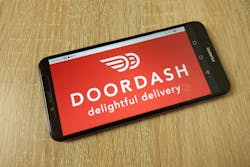Thinking about launching a delivery app? If so, study DoorDash—or its giant rival, Uber Eats— the on-demand food courier service. Strikingly during the pandemic, when the platforms dispatched agile and convenient delivery, home orders skyrocketed. Yet heavy operating costs weighed down mightily on profit margins.
Sound vaguely familiar to automotive hot-shot delivery? High demand and ease with each online order sounds like a failsafe combination for success. But in the practice of daily shuttle runs, wowing installer requirements and meeting financial goals can frustrate supplier expectations.
DoorDash specializes in logistic know-how to the last mile. Its investor prospectus promises an efficient system by connecting customers to restaurants to drivers in what the app calls a "virtuous cycle" of prosperity. And keeping in mind how fast someone carries a hot meal to its destination, success or shortcomings is measured by time and money.
Spending on meal and food delivery apps at the height of the national lockdown revealed that DoorDash generated less than $1 in profit on the average ticket of $36, reported the Wall Street Journal. They explained that DoorDash made substantial payouts in wages, refunds, promotions, advertising, and administrative costs from dual commission streams paid by the restaurant and the customer. Each transaction amounted to a 2.5 percent profit return.
DoorDash had learned through the restaurant-digital network how steep the climb to double-digit profitability could become despite the breezy attitude of placing an order via smartphone.
To some traditional aftermarket businesses, the classic customer order pickup and door-to-door drop-off method may seem safer. Arguably, hedging company resources to a fixed number of transport vehicles and hired hands is potentially self-defeating.
App skeptics, in that respect, should appreciate that these digital services are taking their missteps to heart. Their financial backers believe these teachable moments will improve these companies' logistical abilities to push portable dining to new dimensions. Mobility of this form can lubricate the aftermarket supply chain.
On cue, Uber Eats and Grubhub have taken extra steps to reduce operating costs, such as creating incentives to increase the online order size and bundle relatable items to justify the trip's expense. This initiative translates to saying goodbye to long-haul trips to a repair shop that needs a $6 air filter to complete a job.
Also, refunds contributed to the cost-crushing effects of DoorDash's poor performance. Anecdotal evidence tells that pickers would overlook an item or fail to read special instructions for the sake of saving hot meals. Now that's fixed. Doordash drivers and their restaurant counterparts can view the customer notes marked on the tablets.
Apart from actionable data feeds to streamline smartphone ordering, these incremental improvements can seem painfully apparent for the hub-and-spoke aftermarket except for one thing. When demand surges, even the nimblest store operators typically cannot buy more vehicles or hire more people on short notice. Instead, they must cope with limited capacity.
One spinoff modeled by Uber suggests a promising just-in-time framework. Envision digitally summoning an available driver as required, minimizing the need to overstaff people at any one location. Already gaining traction in China is Full Truck Alliance, an Uber stylized truck mobile app that quickly finds professional drivers for businesses that need to move their inventory. The Wall St. Journal reported that Full Truck Alliance has recently secured more than $1 billion in investor financing for an initial public offering on the New York stock exchange.
Much remains unseen on whether these concepts can exponentially fatten the bottom line or mitigate the shortage of commercial drivers. Nonetheless, eager investors are betting that mobility technology will unknot these loose ends soon enough on the capital front.
In the last decade, Uber famously wooed over vast numbers of gig drivers who could flexibly time in and clock out on their schedule. Hailing a ride quickly and cheaper than taking a cab came to a hard stop mid-April last year due to the global pandemic. Nowadays, Uber and other ride-hail apps like Lyft are desperately trying to attract drivers back with higher wages. Meanwhile, passengers must wait longer and pay more, the antithesis of the original cheap and fast value proposition battled out by Lyft and Uber.
Over time, free-market forces should reverse the higher fares as more people find their way back to the job sector. While it feels tempting to dismiss ride-hailing and fast-food delivery as a non-transferable way to modernize and integrate parts delivery, ignoring the potential to correct the short-term flaws facing these technologies would be equally limiting.
One modification that an app developer may consider is that unlike transporting perishable foods on time, changes on the platform can accommodate a choreographed product arrival when a vehicle is about to be hoisted on the rack. Productivity in the commercial repair shop is by far a leading performance metric. Commercial repairers earn revenue through productive labor hours, which is what the DoorDash inspired entrepreneur must factor into the auto parts delivery app.
Regarding aspirations of this kind, corporate partnerships can open doors. In a pilot program, Walmart signed up DoorDash to handle merchandise drop offs at the customer's home, explained the Wall Street Journal study. This uncomplicated alliance works because Walmart shoppers place orders directly onto the same eCommerce site that signals the DoorDash app, which finalizes the transfer of goods. The Journal found that since Walmart accepted logistical responsibility for the fulfillment activities, including refunds, DoorDash saw its expenses ease. Together and better, Walmart could trust that the DoorDash app drivers would manage multiple stopovers and larger quantities.
While elements of this pilot program are maturing, the prospect of stabilizing variable transport and handling expenses is attainable. DoorDash doubled its bottom-line margin to $2, which in terms of minutes and miles is impressive. Customized app partnerships could accelerate the ease and convenience in a city environment before branching out to the rural areas where farmers and other remote workers lack the freedom to drive into town to the nearest parts store.
What this lesson teaches us is that these players showed creativity to look outside their core businesses. It's also a teachable moment of entrepreneurial spirit.



